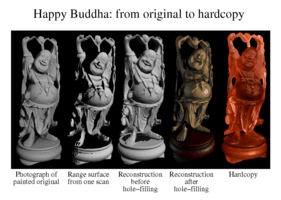
A number of techniques have been developed for reconstructing surfaces by integrating groups of aligned range images. A desirable set of properties for such algorithms includes: incremental updating, representation of directional uncertainty, the ability to fill gaps in the reconstruction, and robustness in the presence of outliers. Prior algorithms possess subsets of these properties. In this paper, we present a volumetric method for integrating range images that possesses all of these properties.
Our volumetric representation consists of a cumulative weighted signed distance function. Working with one range image at a time, we first scan-convert it to a distance function, then combine this with the data already acquired using a simple additive scheme. To achieve space efficiency, we employ a run-length encoding of the volume. To achieve time efficiency, we resample the range image to align with the voxel grid and traverse the range and voxel scanlines synchronously. We generate the final manifold by extracting an isosurface from the volumetric grid. We show that under certain assumptions, this isosurface is optimal in the least squares sense. To fill gaps in the model, we tessellate over the boundaries between regions seen to be empty and regions never observed.
Using this method, we are able to integrate a large number of range images (as many as 70) yielding seamless, high-detail models of up to 2.6 million triangles.
Note: The color figures are included here in both postscript format and JPEG image format. If you wish to view the figures on your monitor, we recommend the JPEG images. If you wish to print the figures on a high quality color printer, then use the postscript files. The postscript files have been gamma-corrected to be brighter for printing.
We do not recommend viewing the hi-res postscript color figure files with a postscript viewer, as they are large, can be slow to display, and many viewers dither the images to give low quality results. Unfortunately, many web browsers automatically load these files and either display them with a postscript viewer or load the postscript text into the browser. Consult your web browser documentation for details on how to download a file without viewing it. When using the Netscape Navigator, for example, hold down the shift key (option key on Macintosh) while clicking on the desired link.